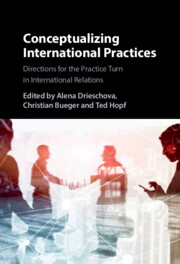Book contents
- Conceptualizing International Practices
- Conceptualizing International Practices
- Copyright page
- Contents
- Figures
- Table
- Contributors
- Acknowledgements
- Part I Introduction: Conversations and the Evolution of Practice Theorizing
- Part II Key Concepts of IR Scholarship
- Part III Innovative Concepts
- 9 The Dynamics of Repetition
- 10 Visibility
- Part IV Conclusion: The Future of Practice Theorizing
- References
- Index
10 - Visibility
Practices of Seeing and Overlooking
from Part III - Innovative Concepts
Published online by Cambridge University Press: 09 June 2022
- Conceptualizing International Practices
- Conceptualizing International Practices
- Copyright page
- Contents
- Figures
- Table
- Contributors
- Acknowledgements
- Part I Introduction: Conversations and the Evolution of Practice Theorizing
- Part II Key Concepts of IR Scholarship
- Part III Innovative Concepts
- 9 The Dynamics of Repetition
- 10 Visibility
- Part IV Conclusion: The Future of Practice Theorizing
- References
- Index
Summary
This chapter explores how the concept of visibility is politically crucial to practice theorizing within IR. It does so by drawing on recent work in social theory to demonstrate how practices of making certain persons, objects, or phenomena seen or unseen work to establish socio-political hierarchies. Specifically, we show how regimes of visibility endow actants with greater or lesser (in-)visibility ‘capital’ that structures what can be seen, heard, and felt about the world. We empirically explore the effects of regimes of visibility through the case of extraordinary rendition (and torture) in the United States and the Syrian Arab Republic, and the affective, political, and social effects of regimes of visibility in this case. Drawing on that discussion, we conclude that practices of making seen or unseen are regimes that predefine the focal point of any (scientific or not) mode of observation or analysis. As a result, the study of any other set of practices are filtered through regimes of visibility and – hence – practices of visibility fashion the way we see all practices. We argue that this central role of regimes of visibility makes their consideration within international practice theory crucial for its research programme.
- Type
- Chapter
- Information
- Conceptualizing International PracticesDirections for the Practice Turn in International Relations, pp. 213 - 234Publisher: Cambridge University PressPrint publication year: 2022
- 1
- Cited by



